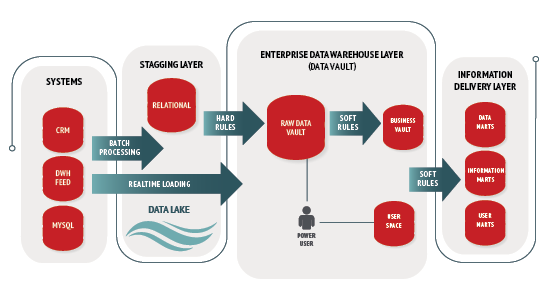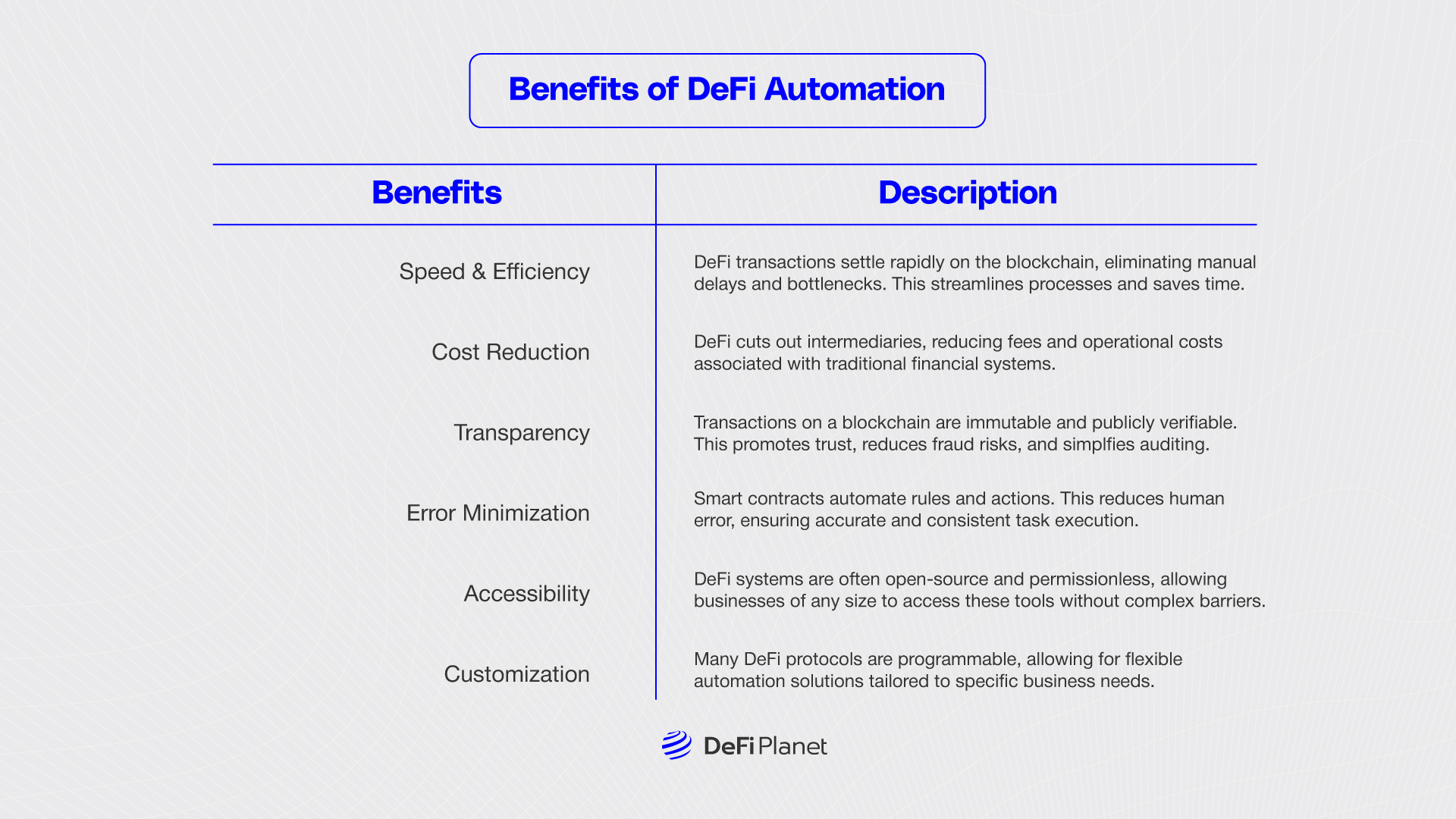DeFi adoption has been on such a rise in recent years that countries that previously regulated it have started to see an easing in these regulations. DeFi uses smart contracts to manage services like savings, loans, and trading. Some of these systems can now run automatically and without the need for so much as a human operation to carry out some of these tasks. This DeFi automation occurs without manual operation and serves to make such transactions smoother and more convenient.
What is DeFi Automation?
DeFi automation simply means using code and smart contracts to make things happen without someone having to click a button or type commands. In DeFi, this could include things like:
- Automatically moving your money to earn higher interest
- Selling your crypto if prices go too low
- Rebalancing your investments across different platforms
With automation tools, users can save time and reduce mistakes, much like having a robot helper in the world of crypto.
The Role of Smart Contracts
Smart contracts are the core engines driving DeFi automation, and their ability to execute predefined actions without human intervention allows users to interact with decentralized protocols in real time, around the clock. Whether it’s managing a lending position, swapping tokens, or moving funds between yield-generating strategies, these contracts act instantly once the set conditions are met.
Take yield farming as an example; instead of constantly monitoring the market, users can set smart contracts to shift liquidity between pools offering the highest returns. If APY drops in one pool, the contract can automatically move the user’s funds to a more profitable one. This automation saves time, avoids missed opportunities, and helps maximize gains.
Smart contracts also reduce emotional decision-making because in traditional finance, investors might panic sell or hesitate during market volatility, but in DeFi, automation means your strategy is locked in. This allows such said strategy to be executed exactly as planned without fear, greed, or second-guessing.
Some protocols offer automation layers where users define custom triggers, like rebalancing a portfolio when asset ratios change, or harvesting and reinvesting yield once it crosses a certain threshold. These automated actions can be bundled, executed in sequence, and tracked transparently on-chain.
Smart contracts will continue to evolve from simple triggers into powerful, composable modules that talk to each other across protocols and blockchains, and their use in DeFi cannot be overemphasized.
How Crypto Bots Automate DeFi
Crypto bots are powerful tools that automate tasks in the world of DeFi. While they were originally popular in centralized exchanges for high-frequency trading, these bots are now playing a growing role in automating DeFi strategies.
These bots can do more than just buy and sell tokens; they can monitor market prices in real time, detect arbitrage opportunities across exchanges, and even execute complex DeFi actions, such as providing liquidity, staking tokens, rebalancing portfolios, or harvesting yield, all without the need for human intervention.
Crypto bots offer a major advantage: they never sleep, and traders and investors can set up rules or algorithms, with the bot carrying out those instructions day or night, even when the user is offline. This is especially useful in the fast-paced crypto market, where prices can change dramatically in seconds.
Popular platforms like 3Commas, Pionex, and Kryll provide user-friendly dashboards where you can build bots using templates or custom logic. These bots can connect to decentralized exchanges (DEXs) and platforms like Uniswap, Aave, or Curve to carry out DeFi operations such as yield farming, liquidity mining, or swapping assets based on market conditions.
Read More: Yield Bearing Assets in Defi, how they work and how you can maximize them
Some advanced bots even use machine learning or AI algorithms to adjust strategies based on market trends. For example, a bot might reduce exposure to volatile assets during a market downturn and move funds into stablecoin pools to preserve value. Some others may optimize gas usage, ensuring that transactions are timed to minimize fees on networks like Ethereum.
Crypto bots can also be programmed to take advantage of vault automation tools, which help users manage DeFi vaults that collect and reinvest returns automatically. This creates a powerful loop of earning, reinvesting, and compounding rewards, without manual effort. In the hands of a thoughtful user, crypto bots are an essential part of DeFi automation, helping users work smarter, not harder, in the ever-changing crypto landscape.

Why DeFi Automation Matters
Many people love the idea of DeFi, but managing everything manually can be overwhelming. In a world where crypto prices move quickly and rewards shift even faster, missing the right moment can lead to losses. It’s easy to get tired or distracted, but that usually ends up costing money.
Automation helps solve this problem by doing much of the work for you; instead of constantly checking charts and managing your assets minute by minute, automation handles those tasks in the background. It can make your investments more efficient by acting instantly when certain market changes happen, helping to reduce risk and improve returns.
RELATED: Best AI-Powered Tools for Managing Crypto Portfolios
For beginners, automation also makes DeFi much easier to explore. You don’t need to be an expert or sit at your computer all day. With the right tools, you can start earning and managing your crypto more confidently, without the stress of doing everything by hand.

Examples of DeFi Automation Platforms
There are several platforms building tools for DeFi automation. Here are a few automation tools:
- Yearn Finance: Offers vaults that move your money between lending platforms to get the best yield.
- Instadapp: Lets users automate tasks like borrowing, paying back loans, or switching protocols.
- Gelato Network: Provides backend automation services to other DeFi apps.
- Chainlink Automation (formerly Keepers): Triggers smart contracts automatically based on real-world data.
These tools are like the “if this, then that” engines of the blockchain world.
Risks of Automation in DeFi
While automation might make DeFi easier and faster, it also comes with quite a bit of risk. Sometimes, the code behind smart contracts can have mistakes, which could lead to losing money. Even the best bots can still make bad decisions, especially when the market is going down fast. Relying too much on bots can also be a problem, especially if they aren’t built well or tested properly. This is why it’s always smart to do your research and stick with platforms that are trusted and well-known.
How to Get Started with DeFi Automation
If you’re new, the best way to start is to try platforms that are beginner-friendly. Yearn Finance is one option, as it automates yield farming with little setup. Another is Beefy Finance, which offers automated yield strategies for many blockchains.
Start small and learn as you go. Make sure to:
- Read the documentation
- Join community forums or Discord groups
- Only invest what you can afford to lose
The Future of DeFi Automation
Future crypto bots will not only follow basic rules but also learn from market patterns using artificial intelligence. This could lead to bots that adapt to changing market conditions more intelligently than ever before. Right now, many automation tools are locked to a single blockchain, but in the future, we may see tools that work across Ethereum, Solana, Arbitrum, Polygon, and other chains. This will allow users to move funds between networks in search of better yields or lower gas fees, all automatically.
With increasing awareness about security risks, developers are focusing on writing safer smart contracts, and future automation platforms will likely include built-in testing environments, real-time audits, and stronger guarantees that the automation won’t fail or get exploited.
Projects like Coinshift are already at the forefront of this shift, helping DAOs (Decentralized Autonomous Organizations) automate how they manage their money and by using these tools, DAOs can stop relying on manual spreadsheets and focus more on growing their communities and achieving their missions.
Beyond Coinshift, platforms like Safe (formerly Gnosis Safe) and Superfluid are exploring continuous payment streaming and real-time treasury updates. These innovations could create a fully autonomous financial layer where salaries, investments, and decisions all run on code.
Finally…
DeFi automation is still new, but it’s becoming an important part of Web3 finance. It makes DeFi easier, smarter, and safer for users. By using smart contracts, crypto bots, and automation tools, even a beginner can start earning from yield farming without needing to be online 24/7.
Like all tools, automation isn’t perfect, but when used wisely, it can help users grow their crypto, protect their investments, and enjoy the benefits of DeFi with less stress.
Disclaimer: This article is intended solely for informational purposes and should not be considered trading or investment advice. Nothing herein should be construed as financial, legal, or tax advice. Trading or investing in cryptocurrencies carries a considerable risk of financial loss. Always conduct due diligence.
If you want to read more market analyses like this one, visit DeFi Planet and follow us on Twitter, LinkedIn, Facebook, Instagram, and CoinMarketCap Community.
Take control of your crypto portfolio with MARKETS PRO, DeFi Planet’s suite of analytics tools.”





















